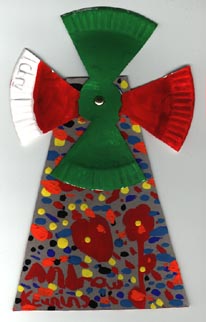Lesson # 1
Grade Level: 4-6
Before going outside a discussion is held about the different types of trees found in the area. Outside the students locate a variety of leaves (or students are instructed to bring leaves to class) and other natural objects. The leaves and objects are placed under drawing paper and rubbed with different colored crayons. The rubbing showing the leaf and its texture is cut-out and pasted onto a larger piece of roll paper to create a leaf tree. The other found objects are also rubbed and added to the base of the leaf tree.
Science Objectives: To be able to identify the different kinds of trees in the school area.
Art Objectives: To recognize shapes and textures in the natural world.
Needed Materials: Drawing paper, crayons, glue, roll paper, leaves and objects
Added Idea Have the students invent their own trees by makiing imaginary leaves based on real leaves.
Lesson #2
Grade Level: 1-6

During a discussion about the energy of the wind introduce the concept of the windmill and how wind power is being used to generate electricity. Show examples of how artists depict the windmill in their art. Have the students draw, paint or make a three dimensional windmill.
Science Objectives: To form an understanding of the use and power of the wind.
Art Objectives: To see how artist use the windmill as a subject. To experience first hand the making of a windmill in two or three dimensions.
Needed Materials:Drawing paper, crayons, paint, paper mache or clay or cardboard, scissors, glue, examples of artists work.
Art work by Cory in the 1st grade
Lesson #3
Grade Level: 4-6
The topic is the cell its functions and components. A discussion is held involving the cell using slides or other types of illustrations. The students are then asked to use a variety of materials to express the shape and parts of the cell. This could become a 2 or 3 dimensional lesson.
Science Objectives: To better understand the cell and its make up.
Art Objectives: To recognize shapes and color. To do a scientific drawing or make a scientific three dimensional shape.
Needed Materials: Paper, crayons, paint, cardboard, paper mache, slides and or illustrations of the cell.
Add on Idea Discuss current cell manipulations. Have the students create drawings showing how plant and animal cells would develope on different planets.
Add on Idea Discuss Geneology. Group the students into partners - have each partner take turns drawing the other. Stress showing the strong features of each other (eys, nose, ears, etc,)
Lesson # 4
Grade Level: 4-6
This lesson involves growth and change such as in the metamorphous of a caterpillar to a butterfly. Following an in-depth discussion on the subject the students are asked to draw and label the caterpillar changing to the butterfly in its various stages. A second assignment involves selecting an item and trying to visualize it changing into something else. An example would be a hammer with its claws changing to a rabbit with its ears. A drawing is made showing the object changing over a period of three or four different images.
Science Objectives: To better understand the concept of metamorphous. To become familiar with the life cycle of the butterfly.
Art Objectives: To recognize changing shapes. To challenge the imagination as it relates to shapes, texture, and color.
Needed Materials: Paper, crayons or paint or other drawing materials.